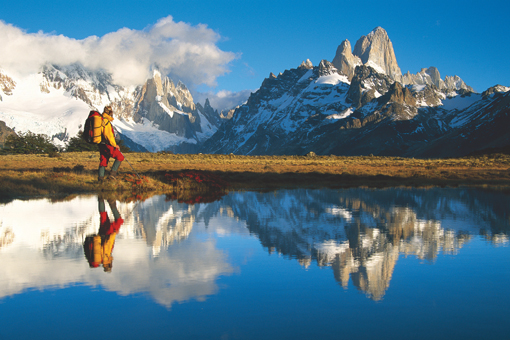Patagonia, the rugged, southern frontier region shared by Argentina and Chile, was once believed to be the home of a race of giants. It still looms large as a wild landscape where myth and reality coincide. The site of major hydro projects, the Argentine Patagonia also boasts four World Heritage sites. The best place to start your adventure is from San Carlos de Bariloche in Rio Negro province. Flights leave Buenos Aires daily. Don’t forget to layer—the weather can be unpredictable.
1. Travel through the Road of the Seven Lakes. The picturesque Ruta de los Siete Lagos takes you through 66.5 miles (107 kms) of unpaved road through forested valleys to view the Patagonian Andes’ seven major lakes: Nahuel Huapi, Espejo, Correntoso, Falkner, Escondido, Machónico, and Villarino.
2. Hike up the Meseta de Somuncurá. This isolated basalt plateau in Río Negro province is the second-largest nature reserve in Argentina. Home to volcanic lagoons and the majestic condor, it is also the summer residence for shepherds during the breeding season.
3. Watch the whales. Puerto Madryn is the gateway to the Península Valdés wildlife sanctuary, where you can glimpse orca and baleen whales, sea elephants, sea lions, and Magellanic penguins. (170 pesos)
4. Waddle over to Punta Tombo. If you can’t get enough of penguins, head to Punta Tombo, a peninsula jutting into the Atlantic from Chubut province that is home to Patagonia’s most important Magellanic penguin colony. Thousands of penguins arrive at this spot between September and April to breed. (70–130 pesos)
5. Discover an ancient forest. The storied alerces in Los Alerces National Park in Argentina’s Chubut province are among the world’s oldest trees—with some reaching 3,000 years old. Eat lunch beneath the shade of a towering tree, then go fishing for dinner in one of the park’s many lakes. (80 pesos)
6. Touch a glacier. Parque Nacional los Glaciares is the best place in South America to see immense glaciers stretching out infinitely before you. Hike across Perito Moreno Glacier, one of only three Patagonian glaciers that are still growing. (215 pesos)
7. Commune with nature. El Chaltén, on Argentina’s border with Chile, is called the “national capital of trekking.” Located within Parque Nacional de los Glaciares, it offers overnight campsites and is the perfect base site for hikes.
8, Explore the coast. The Parque Nacional Monte León’s steppes, tidal flats and headlands are also one of the world’s most biodiverse areas—including medicinal grasses and 20 species of marine and coastal birds. (Free)
9. See prehistoric cave art. The Cueva de las Manos (Cave of Hands) contains an exceptional collection of cave art created between 9,500 and 13,000 years ago. The cave’s name is derived from the stenciled outlines of hands in the cave, but the art also includes hunting scenes and depictions of animals native to Patagonia. (32 pesos)
10. Soak your aching feet. After all that trekking, you’ll welcome a soothing dip in the remote Lago Posadas, a glacial lake near the town of Hipólito Yrigoyen, with a distinctive turquoise hue. Seldom visited, it’s well worth the detour off Route 40.
View a slideshow of different spots in Patagonia, Argentina.
Photos 1-6 courtesy of Adam Wolsky. Photos 7-8 courtesy of Giselle Diez.





